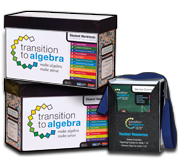
Often, algebra students see equations and immediately turn to solving steps: What variable am I solving for? What can I do to both sides to simplify this equation? For students to develop a deep understanding and confidence when solving equations, however, it’s important for them to have other strategies for approaching them.
In Transition to Algebra, Mystery Number Puzzles are used specifically because they require students to reason through the meaning of the information being presented—they don’t lend themselves to a one-size-fits-all problem solving approach. Successful algebra students often use a strategy called chunking. In it, they use what they know about an equation’s structure and the algebraic properties involved to reason about the value of a chunk of information, working backward from there toward the value of a variable. Mystery Number Puzzles build scaffolding for students to develop this kind of thinking and build the logic for themselves.
Watch Jane Kang, one of the coauthors of the Transition to Algebra program, talk about how Mystery Number Puzzles are used to help students learn to reason through different kinds of equations.
-
Speed1x
-
Quality540p

Thanks for reporting a problem. We'll attach technical data about this session to help us figure out the issue. Which of these best describes the problem?
Any other details or context?
To see more videos of Jane talking about Transition to Algebra’s unique approach to algebra instruction, please visit TransitiontoAlgebra.com.
♦ ♦ ♦ ♦
 Transition to Algebra (TTA) grew out of an initiative of the Learning and Teaching Division at Education Development Center (EDC), an acclaimed curriculum development laboratory specializing in science and mathematics instruction. Building on EDC’s hands-on, inquiry-based approach to learning, TTA uses algebraic logic puzzles and explorations to help students shift their ways of thinking from the concrete procedures of arithmetic to the abstract reasoning that success with algebra requires. Learn more.
Transition to Algebra (TTA) grew out of an initiative of the Learning and Teaching Division at Education Development Center (EDC), an acclaimed curriculum development laboratory specializing in science and mathematics instruction. Building on EDC’s hands-on, inquiry-based approach to learning, TTA uses algebraic logic puzzles and explorations to help students shift their ways of thinking from the concrete procedures of arithmetic to the abstract reasoning that success with algebra requires. Learn more.


